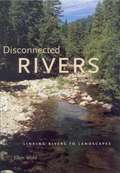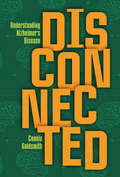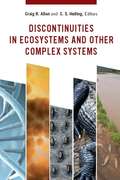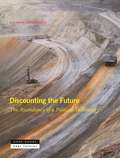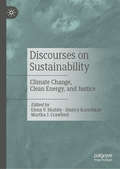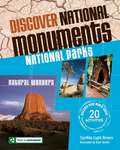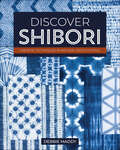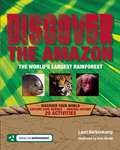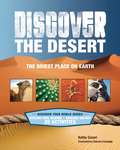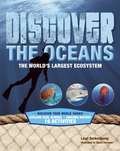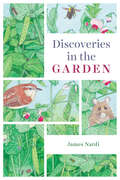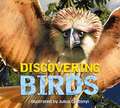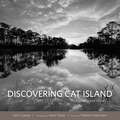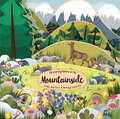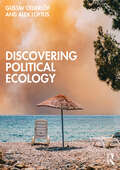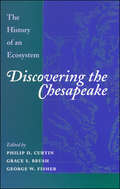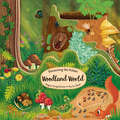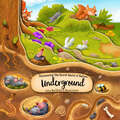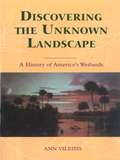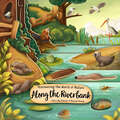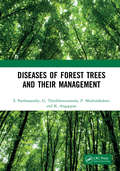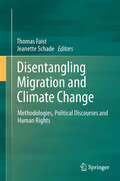- Table View
- List View
Disconnected Rivers: Linking Rivers to Landscapes
by Ellen E. WohlThis important and accessible book surveys the history and present condition of river systems across the United States, showing how human activities have impoverished our rivers and impaired the connections between river worlds and other ecosystems. Ellen Wohl begins by introducing the basic physical, chemical, and biological processes operating in rivers. She then addresses changes in rivers resulting from settlement and expansion, describes the growth of federal involvement in managing rivers, and examines the recent efforts to rehabilitate and conserve river ecosystems. In each chapter she focuses on a specific regional case study and describes what happens to a particular river organism--a bird, North America's largest salamander, the paddlefish, and the American alligator--when people interfere with natural processes.
Disconnected: Understanding Alzheimer's Disease
by Connie Goldsmith“The common perception of Alzheimer’s from people who haven’t experienced it is that it’s more like a ‘quirk’ which all elderly people experience at some point. But Alzheimer’s is so much more than simple forgetfulness. With the memory loss comes confusion . . . What was once the bedroom turns into a frightening place . . . . They may not recognize family members and instead see them as strangers with unknown intentions. This gives them so much stress every day that they may lash out or become depressed.” —Charlie Poole, Alzheimer’s caregiver Alzheimer’s patients are one of the fastest-growing populations among aging communities in the United States. In 2024 roughly 6.9 million Americans aged sixty-five and older had Alzheimer’s disease. By 2050 that number is set to nearly double. An Alzheimer’s diagnosis affects more than just the patient—it impacts their family and friends too. As the disease progresses, the patient’s memory deteriorates, and their behavior may suddenly change. They may need more attention, care, and supervision. Many people are thrust into the role of a caregiver without preparation or knowledge of what's to come. In Disconnected: Understanding Alzheimer’s Disease, author and registered nurse Connie Goldsmith looks at the stages of Alzheimer’s, details current clinical research, and shares more than a dozen stories of patients and their families. No matter what age you are, it’s important to grow awareness for Alzheimer’s, recognize its signs and symptoms—and learn what you can do in the event that someone you love is diagnosed with the disease.
Discontinuities in Ecosystems and Other Complex Systems
by C. S. Holling Craig R. AllenA Major Contribution to Theoretical Ecology
Discontinuities in Ecosystems and Other Complex Systems (Complexity in Ecological Systems)
by C. S. Holling Craig R. Allen Eds.Following the publication of C. S. Holling's seminal work on the relationship between animal body mass patterns and scale-specific landscape structure, ecologists began to explore the theoretical and applied consequences of discontinuities in ecosystems and other complex systems. Are ecosystems and their components continuously distributed and do they adhere to scaling laws, or are they discontinuous and more complex than early models would have us believe? The resulting propositions over the structure of complex systems sparked an ongoing debate regarding the mechanisms generating discontinuities and the statistical methods used for their detection.This volume takes the view that ecosystems and other complex systems are inherently discontinuous and that such fields as ecology, economics, and urban studies greatly benefit from this paradigm shift. Contributors present evidence of the ubiquity of discontinuous distributions in ecological and social systems and how their analysis provides insight into complex phenomena. The book is divided into three sections. The first focuses on background material and contrasting views concerning the discontinuous organization of complex systems. The second discusses discontinuous patterns detected in a number of different systems and methods for detecting them, and the third touches on the potential significance of discontinuities in complex systems. Science is still dominated by a focus on power laws, but the contributors to this volume are convinced power laws often mask the interesting dynamics of systems and that those dynamics are best revealed by investigating deviations from assumed power law distributions.In 2008, a grand conference on resilience was held in Stockholm, hosting 600 participants from around the world. There are now three big centers established with resilience, the most recent one being the Stockholm Resilience Center, with others in Australia (an international coral reef center), Arizona State University's new sustainability center focusing on anthropology, and Canada's emerging social sciences and resilience center. Activity continues to flourish in Alaska, South Africa, and the Untied Kingdom, and a new center is forming in Uruguay.
Discounting the Future: The Ascendancy of a Political Technology
by Liliana DoganovaA pioneering exploration of the defining traits and contradictions of our relationship to the future through the lens of discountingForest fires, droughts, and rising sea levels beg a nagging question: have we lost our capacity to act on the future? Liliana Doganova&’s book sheds new light on this anxious query. It argues that our relationship to the future has been trapped in the gears of a device called discounting. While its incidence remains little known, discounting has long been entrenched in market and policy practices, shaping the ways firms and governments look to the future and make decisions accordingly. Thus, a sociological account of discounting formulas has become urgent.Discounting means valuing things through the flows of costs and benefits that they are likely to generate in the future, with these future flows being literally dis-counted as they are translated in the present. How have we come to think of the future, and of valuation, in such terms? Building on original empirical research in the historical sociology of discounting, Doganova takes us to some of the sites and moments in which discounting took shape and gained momentum: valuation of European forests in the eighteenth and nineteenth centuries; economic theories devised in the early 1900s; debates over business strategies in the postwar era; investor-state disputes over the nationalization of natural resources; and drug development in the biopharmaceutical industry today. Weaving these threads together, the book pleads for an understanding of discounting as a political technology, and of the future as a contested domain.
Discourses of Global Climate Change: Apocalyptic framing and political antagonisms (Routledge Studies in Environmental Communication and Media)
by Martin Hultman Jonas AnshelmThis book examines the arguments made by political actors in the creation of antagonistic discourses on climate change. Using in-depth empirical research from Sweden, a country considered by the international political community to be a frontrunner in tackling climate change, it draws out lessons that contribute to the worldwide environmental debate. The book identifies and analyses four globally circulated discourses that call for very different action to be taken to achieve sustainability: Industrial fatalism, Green Keynesianism, Eco-socialism and Climate scepticism. Drawing on risk society and post-political theory, it elaborates concepts such as industrial modern masculinity and ecomodern utopia, exploring how it is possible to reconcile apocalyptic framing to the dominant discourse of political conservatism. This highly original and detailed study focuses on opinion leaders and the way discourses are framed in the climate change debate, making it valuable reading for students and scholars of environmental communication and media, global environmental policy, energy research and sustainability.
Discourses on Sustainability: Climate Change, Clean Energy, and Justice
by Martha J. Crawford Elena V. Shabliy Dmitry KurochkinThis volume presents an in-depth analysis of climate change problems and discusses the proliferation of renewable energy worldwide—in conjunction with such important questions as social justice and economic growth, providing an interdisciplinary approach to sustainable development. Exploring various responses to human-induced climate change, the book offers a critical reflection on climate change and clean energy and highlights the fundamental problems of international energy justice and human rights. Examining these and other climate-related issues from legal, business, political, and scientific perspectives, the volume also analyzes the impact of economic factors and policies on climate change mitigation and adaptation.
Discover National Monuments
by Cynthia Light Brown Blair SheddFascinating facts about America's most popular natural landmarks provide the backbone for this fun-filled collection of activities that replicate the organic processes that formed them. Interspersed with history, factoids, and sidebars, this engaging reference explores scientific concepts, such as the formation of coral reefs and the cause of volcanic eruptions. Each monument-from the Lava Beds to the Petrified Forest-is showcased in a graphic multipage spread and is followed by hands-on experiments, allowing children to make their own stalactites and discover how a river can erode rock into a canyon. Expressing true appreciation for the United States' natural wonders, this comprehensive guide clearly illustrates their formation, from glittering caves to giant trees.
Discover Shibori: Creative Techniques in Natural Indigo Dyeing
by Debbie MaddyExplore the captivating world of traditional Shibori techniques. Learn techniques such as shape resist, stitch resist, pole wrapping, pleat, bind, looped binding, and bound resist in this practical guide by expert shibori teacher Debbie Maddy. From selecting and preparing fabrics to setting and maintaining an indigo vat, this book provides a solid foundation for beginners while also delving into sophisticated techniques such as Katano pleating and stitching that will elevate your projects. Apply your newly acquired skills in six inspiring projects to showcase your freshly dyed fabric, including a scarf, a shawl, an apron, a pillow, a table runner, and a quilt. Not just the basics of shibori and indigo dyeing, discover unique techniques to elevate your craft Learn 35 meditative shibori techniques, including wrapping, pleating, folding, slow stitching, and more Master three natural indigo vats and show off your dyed fabrics in six stunning projects, including a pillow, table runner, quilt, apron, scarf, and shawl
Discover the Amazon
by Blair Shedd Lauri BerkenkampFrom avoiding predators to navigating through the jungle without a compass, this innovative guide provides kids with the vital tools one would need if lost in the Amazon. Offering practical survival techniques based on real stories, children will learn lessons that can be adapted to almost any outdoor situation, such as making fire, deciphering animal tracks, and using the natural world for all to create necessary supplies. Opening with an informative section on the region and its people, this essential resource combines history and science in a fun and engaging way. Facts and sidebars on the local creatures and plants are interspersed along with 15 activities for the home or classroom-from making a fishing spear to determining how much water is needed to stay healthy.
Discover the Desert
by Sam Carbaugh Kathryn CeceriDelving into a seemingly dry and barren ecosystem, this fun-filled activity book closely examines the desert landscape and shows how many exciting discoveries it holds. Exploring native plants and animals and depicting the extreme temperatures, rough terrain, and vast distances in detail, this lively reference describes lost civilizations as well as today's desert-dwelling cultures. "Try This" science and history activities are also included-from creating mirages and fashioning an Anasazi clay bowl to growing salt crystals and even assembling a cactus dish terrarium. Demonstrating why adventurers have always been drawn to the world's deserts, this entertaining overview also provides education on the environment, examining how the health of the planet depends on the careful treatment of the desert's many resources.
Discover the Oceans
by Lauri Berkenkamp Chuck ForsmanFrom both a historical and scientific point of view, above and below the surface, this engaging guide brings the world's oceans to life through fun facts, illustrations, and in-depth information. Interactive activities appear throughout, ranging from making solar stills and simple fishing spears to experimenting with a homemade diving bell and figuring out how much water it really takes to survive. With the oceans being the least explored environment on Earth, this reference illuminates some of the most incredible and surprising plants and animals as well as how to survive and navigate these vast expanses.
Discoveries in the Garden
by James B. NardiEvery square inch of soil is rich with energy and life, and nowhere is this more evident than in the garden. At the tips of our trowels, a sun-driven world of microbes, insects, roots, and stems awaits—and it is a world no one knows better than James Nardi. A charming guide to all things green and growing, Nardi is as at home in prairies, forests, and wetlands as he is in the vegetable patch. And with Discoveries in the Garden, he shows us that these spaces aren’t as different as we might think, that nature flourishes in our backyards, schoolyards, and even indoors. To find it, we’ve only got to get down into the dirt. Leading us through the garden gate, Nardi reveals the extraordinary daily lives and life cycles of a quick-growing, widely available, and very accommodating group of study subjects: garden plants. Through close observations and simple experiments we all can replicate at home, we learn the hidden stories behind how these plants grow, flower, set seeds, and produce fruits, as well as the vital role dead and decomposing plants play in nourishing the soil. From pollinators to parasites, plant calisthenics to the wisdom of weeds, Nardi’s tale also introduces us to our fellow animal and microbial gardeners, the community of creatures both macro- and microscopic with whom we share our raised beds. Featuring a copse of original, informative illustrations that are as lush as the garden plants themselves, Discoveries in the Garden is an enlightening romp through the natural history, science, beauty, and wonder of these essential green places.
Discovering Birds: The Ultimate Handbook to the Birds of the World
by Roger LedererTake a journey through the fascinating world of birds with this tactile book jam-packed with scientific facts and incredible full-color illustrations.From soaring eagles to colorful parrots, this book explores the diverse array of birds that inhabit our world. Learn about each species' life cycle, nesting habits, migration patterns, behaviors, physical characteristics, and distinct songs.Inside you'll find:Profiles of 100+ amazing birds across a range of habitatsFun facts highlighting the fascinating features of each speciesIncredible full-page illustrationsDesigned to inspire curiosity and a love of nature, Discovering Birds promises to encourage a lifelong appreciation of learning and the great outdoors.
Discovering Cat Island: Photographs and History
by John CuevasCat Island, just off the Mississippi Gulf Coast shoreline, has been home to some of the most dramatic events and remarkable stories in the nation's history. While some of these stories are fact, others are colorful fables passed down through the ages with such conviction they have become true in the hearts and minds of many. Between fact and fiction is the undeniable reality: Cat Island is one of the most historically significant landmarks on the Mississippi Gulf Coast.Featuring over 160 black-and-white photographs by Jason Taylor and a foreword by Mississippi's Secretary of State Delbert Hosemann, John Cuevas's Discovering Cat Island guides readers through Cat Island with stories and histories of twenty-nine sites--both real and imagined--of the legendary barrier island. Originally owned by the Cuevas family as part of a Spanish land grant to Juan de Cuevas in 1781, Cat Island boasts a colorful history that includes events related to the notorious pirate Jean Lafitte and the outlaw James Copeland, both of whom were thought to have buried their stolen treasure somewhere on the island; the Battle of New Orleans; and the War of 1812. The island served as one of the staging areas for the Seminole forced to abandon their homes and take part in the Trail of Tears. In the twentieth century, the island was a convenient transfer point for gangsters and local bootleggers shipping booze during Prohibition before becoming a US military training camp site during World War II. In 1988, Cat Island became the location of the first oil drilling ever in the Mississippi Sound and in 2010 was one of the islands devastated by the BP Deepwater Horizon oil spill.
Discovering Nature on the Mountainside
by Lenka Chytilová Hedviga GutierrezThis beautifully illustrated and educational children&’s book explores mountain wildlife and how different animals live through the seasons. Strap on your boots and set out to explore a gorgeous mountainside! Discover all the amazing animals that call the mountains home. See how they live throughout the seasons—from bears and bats to eagles, mountain goats, marmots, and so much more. From which animals turn white when it snows to which are the best ice and rock climbers, young readers will learn all kinds of fun facts in this delightful picture book. This is a fixed-format ebook, which preserves the design and layout of the original print book
Discovering Political Ecology
by Alex Loftus Gustav CederlöfPolitical ecology is one of the most vibrant fields of environmental research. This book introduces political ecology to a new generation of students in a daring new way: as an interdisciplinary approach to environmental research but also as a series of lived realities and a praxis for change. The origins of political ecology are often traced through an Anglo-American canon. In Discovering Political Ecology, Gustav Cederlöf and Alex Loftus instead take up the challenge of presenting the key conversations and the diverse traditions that have shaped this field with attention to its extensive international roots. Inspired by voices and research in Asia, Africa, Europe and the Americas, the authors address the concerns of those who from different social backgrounds have grown up in a world shaped by climate change and increasing environmental inequalities.Engaging and accessible in style, Discovering Political Ecology introduces a set of key concepts around which conversations in political ecology coalesce. It also shows how these concepts allow you to make sense of some of the most pressing issues of our time—issues around water, energy, agriculture, forestry, climate change and environmental justice. Each chapter includes learning outcomes and suggested further readings, extensive bibliographies and seminar activities to be used by students and educators. At the cutting edge of the field, the book will be of interest to those in all disciplines brought together in political ecology, including but not limited to anthropology, development studies, ecology, geography, history and political science.
Discovering the Chesapeake: The History of an Ecosystem
by George W. FisherWith its rich evolutionary record of natural systems and long history of human activity, the Chesapeake Bay provides an excellent example of how a great estuary has responded to the powerful forces of human settlement and environmental change. Discovering the Chesapeake explores all of the long-term changes the Chesapeake has undergone and uncovers the inextricable connections among land, water, and humans in this unusually delicate ecosystem.Edited by a historian, a paleobiologist, and a geologist at the Johns Hopkins University and written for general readers, the book brings together experts in various disciplines to consider the truly complex and interesting environmental history of the Chesapeake and its watershed. Chapters explore a variety of topics, including the natural systems of the watershed and their origins; the effects of human interventions ranging from Indian slash-and-burn practices to changing farming techniques; the introduction of pathogens, both human and botanical; the consequences of the oyster's depletion; the response of bird and animal life to environmental factors introduced by humans; and the influence of the land and water on the people who settled along the Bay.Discovering the Chesapeake, originating in two conferences sponsored by the National Science Foundation, achieves a broad historical and scientific appreciation of the various processes that shaped the Chesapeake region."Today's Chesapeake Bay is only some ten thousand years old. What a different world it was... when the region was the home of the ground sloth, giant beaver, dire wolf, mastodon, and other megafauna. In the next few thousand years, the ice may form again and the Bay will once more be the valley of the Susquehanna, unless, of course, human-induced changes in climate create some other currently unpredictable condition."—from the Introduction
Discovering the Hidden Woodland World
by Magda Garguláková Martin ŠodjrThis whimsical children&’s book takes young readers on a unique adventure into the forest to see the amazing ecosystem of trees. You&’ve seen plenty of old tree trunks, but have you ever thought about the forest animals and insects who rely on them to survive? With delightful illustrations, educational captions, and vocabulary words, this book reveals some of nature&’s most fascinating secrets. From the important role old tree trunks play in the natural world to which insect loves the taste of rotten wood, how trees tell their life story, and so much more, kids will have a blast seeing trees and tree stumps in a whole new light! This is a fixed-format ebook, which preserves the design and layout of the original print book
Discovering the Secret World of Nature Underground
by Petra Bartíková Marcel KrálikYoung readers discover the fascinating world of animals and insects that live underground in this beautifully illustrated children&’s book. Have you ever wondered what it would be like to be an animal that lives underground? Now you can find out! With each turn of the page, this engaging picture book reveals dozens of adorable illustrations, educational captions, vocabulary words, and more—all exploring the underground habitat of several kinds of animals. From rabbits and mice to badgers, ants, and other insects, children will love learning all about these busy animals that burrow below! This is a fixed-format ebook, which preserves the design and layout of the original print book
Discovering the Unknown Landscape: A History Of America's Wetlands
by Ann VileisisThe rapidly disappearing wetlands that once spread so abundantly across the American continent serve an essential and irreplaceable ecological function. Yet for centuries, beginning with the first European settlers, Americans have viewed them with disdain. As neither dry land, which can be owned and controlled by individuals, nor bodies of water, which are considered a public resource, wetlands have in recent years been at the center of controversy over issues of environmental protection and property rights.The confusion and contention that surround wetland issues today are the products of a long and convoluted history. In Discovering the Unknown Landscape, Anne Vileisis presents a fascinating look at that history, exploring how Americans have thought about and used wetlands from Colonial times through the present day. She discusses the many factors that influence patterns of land use -- ideology, economics, law, perception, art -- and examines the complicated interactions among those factors that have resulted in our contemporary landscape. As well as chronicling the march of destruction, she considers our seemingly contradictory tradition of appreciating wetlands: artistic and literary representations, conservation during the Progressive Era, and recent legislation aimed at slowing or stopping losses.Discovering the Unknown Landscape is an intriguing synthesis of social and environmental history, and a valuable examination of how cultural attitudes shape the physical world that surrounds us. It provides important context to current debates, and clearly illustrates the stark contrast between centuries of beliefs and policies and recent attempts to turn those longstanding beliefs and policies around. Vileisis's clear and engaging prose provides a new and compelling understanding of modern-day environmental conflicts.
Discovering the World of Nature Along the Riverbank
by Petra Bartíková Marcel KrálikWith delightful illustrations and fascinating facts aimed at young readers, this children&’s book explores the natural world of riverbanks. Have you ever wondered how and why beavers build their dams, how otters live, or how frogs come to be? Now you can find out! This charming picture book teaches young children what it&’s like to be an animal living on and in the water. With each turn of the page, this volume reveals dozens of adorable illustrations, educational captions, and vocabulary words. From beavers and otters to snakes, frogs, newts, and more, children will love learning all about these busy aquatic animals and the amazing lives they live! This is a fixed-format ebook, which preserves the design and layout of the original print book
Diseases of Forest Trees and their Management
by S. Parthasarathy G. Thiribhuvanamala P. Muthulakshmi K. AngappanThe book is intended to provide comprehensive introduction to the important aspects of the field of forest pathology and tree diseases. The book is arranged in two major parts. The fundamental chapters, present forest diseases, pathogens, epidemics, and management that is applicable to all forest trees. The applied chapters on the individual crops that are grouped alphabetically present information on the symptoms, pathogen and integrated management of major diseases of forest trees. It was designed to give a broad overview of the field of forest pathology but with sufficient detail that they will be able to assess their specific role as practicing forestry professionals.Note: T& F does not sell or distribute the Hardback in India, Pakistan, Nepal, Bhutan, Bangladesh and Sri Lanka.
Disentangling Migration and Climate Change: Methodologies, Political Discourses and Human Rights
by Thomas Faist Jeanette SchadeThis book addresses environmental and climate change induced migration from the vantage point of migration studies, offering a broad spectrum of approaches for considering the environment/climate/migration nexus. Research on the subject is still frequently narrowed down to climate change vulnerability and the environmental push factor. The book establishes the interconnections between societal and environmental vulnerability, and migration and capability, allowing appreciation of migration in the frame of climate as a case of spatial and social mobility, that is, as a strategy of persons and groups to deal with a grossly unequal distribution of life chances across the world. In their introduction, the editors fan out the current debate and state the need to transcend predominantly policy-oriented approaches to migration. The first section of the volume focuses on "Methodologies and Methods" and presents very distinct approaches to think climate induced migration. Subsequent chapters explore the sensitivity of existing migration flows to climate change in Ghana and Bangladesh, the complex relationship between migration, demographic change and coping capacities in Canada, methodological challenges of a household survey on the significance of migration and remittances for adaptation in the Hindu Kush region and an econometric study of the aftermath of the 1998 floods in Bangladesh. The second part, "Areas of Concern: Politics and Human Rights", deepens the analysis of discourses as well as of the implications of proposed and implemented policies. Contributors discuss such topics as environmental migration as a multi-causal problem, climate migration as a consequence in an alarmist discourse and climate migration as a solution. A study of an integrated relocation program in Papua New Guinea is followed by chapters on the promise and the flaws of planned relocation policy, global policy on protection of environmental migrants including both internally displaced peoples and those who cross international borders. A concluding chapter places human agency at centre stage and explores the interplay between human rights, capability and migration.
Diskursive Dynamiken und Policy-Wandel in der EU-Energiepolitik: Eine Blended-Reading-Diskursanalyse des ordentlichen Gesetzgebungsverfahrens der EU von 1992 bis 2019 (Studien der NRW School of Governance)
by Tobias RammelWie lässt sich Policy-Wandel in der Europäischen Union erklären? Tobias Rammel beantwortet diese Frage erstmals für die Gesamtheit des ordentlichen Gesetzgebungsverfahrens zur EU-Energiepolitik von 1992 bis 2019 im Rahmen einer Blended-Reading-Diskursanalyse. Rekurrierend auf eine Analyse des Forschungsstandes zur EU-Energiepolitik wird in diesem Buch argumentiert, dass eine theoretische Synthese der Arbeiten zur Diskursanalyse und zum Policy-Wandel die bisherigen Defizite der klassischen Theorieschulen ausgleichen kann. Methodisch wird in einem innovativen dreistufigen Forschungsdesign auf eine Blended-Reading-Kombination von Close-Reading in Form von unüberwachten Text-Mining-Verfahren (Topic Modeling) zur induktiv-explorativen Vorstrukturierung der Analyse und Distant-Reading in Form einer qualitativen Feinanalyse zur Interpretation und Kontextualisierung der Daten zurückgegriffen. Damit liefert das Buch eine bislang einzigartige und differenzierte Erklärung für Policy-Wandel und die dazugehörigen diskursiven Dynamiken zwischen den EU-Institutionen im COD der EU-Energiepolitik von 1992 bis 2019.
